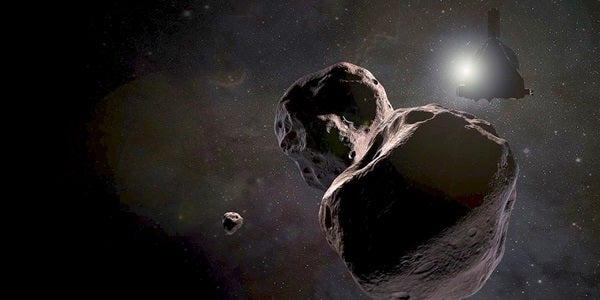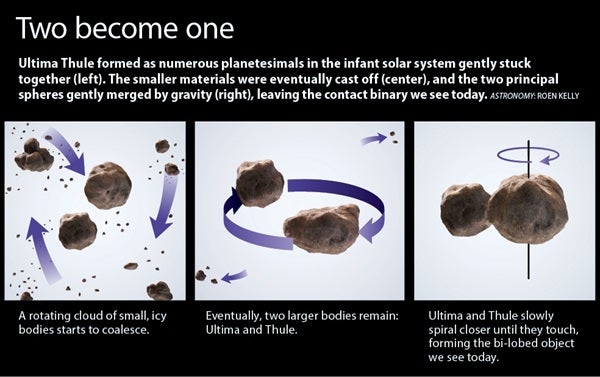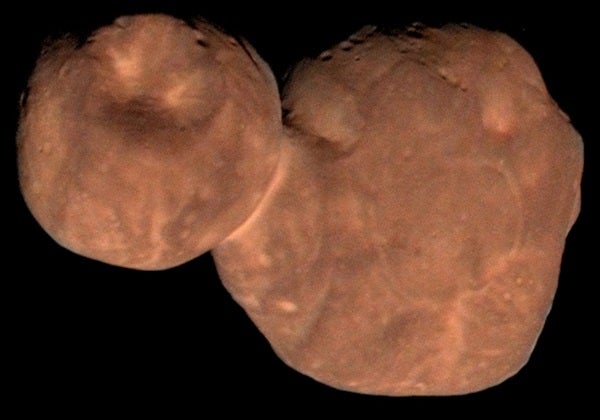On January 1, 2019 NASA’s New Horizons spacecraft provided humanity its first up-close look at an object from the solar system’s beginnings: the primordial Kuiper Belt object Arrokoth. But, it turns out, determining exactly how primordial Arrokoth is could be more complicated than it seems.
In new research published August 3 in the journal Icarus, planetary scientist Jordan K. Steckloff of the Planetary Science Institute and his colleagues assert Arrokoth itself still dates back billions of years to shortly after the solar system’s birth, but the researchers think its surface may be significantly younger, having received a facelift thanks to surface “breezes.” However, although their new claim is undoubtedly intriguing, at least one major Arrokoth advocate wants more information before jumping on board.
A cold, lonely existence
Located more than 4 billion miles (6.4 billion kilometers) from Earth, Arrokoth formed in a distant, extremely frigid region of the solar system, Steckloff tells Astronomy. There, the temperature hovers around –418 degrees Fahrenheit (–250 degrees Celsius), which is cold enough to freeze carbon monoxide and methane. According to Steckloff, early on, “Arrokoth [also] was sort of behind a smoke screen — the thick protoplanetary disk,” which helped keep it chilly.
But when the Sun was about 10 million years old, just a protostar still powered by gravitational contraction, it entered its T Tauri evolutionary phase. It started blowing powerful solar winds off its surface. And as the Sun’s protoplanetary disk dissipated, Arrokoth’s temperature began to rise. Frozen volatiles evaporated in a process called sublimation, with some, like carbon monoxide, boiling away more vigorously than others.
Such outgassing can change the rotation of objects like comets or asteroids, or even tear them apart. But that didn’t happen to Arrokoth. However, sublimation can also alter cometary surfaces. Unlike comets, Steckloff says, carbon monoxide, rather than water ice, was a major supervolatile on Arrokoth.
“These molecules would have been moving fast, around 100 to 200 meters per second [225 to 450 miles per hour],” he says. “The pressure of the gas at Arrokoth’s surface would be, at most, a nanobar — a billionth of the pressure at the Earth’s surface. But the surface gravity is also very low — about one ten-thousandth the gravity at the surface of the Earth. So, if you have fine dust, the [sublimating gas will] move it.”
And given 10 to 100 million years for this process to unfold, Steckloff and his colleagues think this slow carbon monoxide “breeze” would have made the kinds of changes to Arrokoth’s surface that any earthly geologist would recognize. Steckloff admits they were slow changes — but they were “significant enough to erase topographic features on length scales of about 10 to 100 meters [33 to 330 feet].”
The end result was the effective disappearance of impact craters 50 to 500 meters (165 to 1,650 feet) in diameter. “So, when we look at Arrokoth,” Steckloff says, “the shape may be primordial, but the surface might date from a later period.”
Beyond the surface
Alan Stern, principal investigator of the New Horizons mission to Pluto and Arrokoth, tells Astronomy he’s impressed by the ingenuity the researchers have shown in the paper. “I think they have a very innovative idea,” he says. However, Stern remains cautious: “I am not sure the surface telltales are likely to be as dramatic as the paper describes.”
Stern notes the “breezes” described in the paper would be only one of the processes occurring during the earliest phases of Arrokoth’s formation. “There was a slow tail to accretion, to thermal evolution, to space weathering by the radiation environment, [to] effects in the disk which was still dissipating,” he says. “All this was going on at once and at different time scales.”
He also notes a need for follow-up work to determine whether “other Kuiper Belt objects would be similarly affected, and how we would go about determining if this is, in fact, what actually happened — either with future missions to the Kuiper Belt, or by observing comet belts around T Tauri stars and looking for telltales of this kind of process.
“What remains to be seen with more detailed modeling or with these observations — either future missions or observations of stars — is to determine just how important this [surface sublimation] process really is,” he adds.
No matter what, Arrokoth still remains the most pristine relic of the solar system’s formation ever closely examined by a spacecraft. And even if cryogenic breezes altered its surface after its initial formation, it’s still about as old of a surface as we’ve ever seen up close. So, as researchers continue to pour over the data produced by New Horizons’ historic flyby, many more surprising results are sure to follow.
Joel Davis (@joeldaviswriter) is a frequent contributor to Astronomy.












